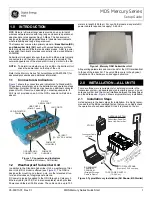
Cabling Types
11-9
FDDI Media
There are two basic types of fiber optics: multimode and single mode. The names
come from the types of light used in the transmission process. Multimode fiber
uses inexpensive Light Emitting Diodes (LEDs) that produce light of a single
color. Due to the nature of the LED, the light produced is made up of a number of
differing wavelengths of light, fired outward from the center of the LED. Not all
the rays of light enter the fiber, and those that do often do so at an angle, which
reduces the amount of distance the signal can effectively cover. Single mode fiber
optics use lasers to achieve greater maximum distances. Since light from a laser is
all of the same wavelength, and travels in a coherent ray, the resulting signal
tends to be much clearer at reception than an LED signal under the same
circumstances.
Fiber optics of both types are measured and identified by a variety of means. The
usual means of referring to a fiber optic cable type is to identify if it is single mode
or multimode, and to describe the thickness of each strand. Fiber optics are very
thin, and the width of each strand is measured in microns (
µ
m). Two
measurements are important in fiber optic identification: the diameter of the core,
where signals travel, and the diameter of the cladding, which surrounds the core.
Thus, fiber optic measurements will usually provide two numbers separated by
the “/” symbol. The first number is the diameter, in microns, of the core. The
second is the diameter of the cladding. Thus, a 62.5/125 multimode cable is a type
of fiber optic cabling with a 62.5
µ
m core and 125
µ
m cladding, which can be used
by inexpensive LED equipment, as it allows multiple modes of light to pass
through it. Incidentally, 62.5/125
µ
m multimode cabling is a very common type of
FDDI fiber optics.
In much the same way that UTP cabling is available in two-, four-, 25-, and 50-pair
cables, strands of fiber optic cabling are often bound together with other strands
into multiple strand cables. These multiple strand cables are available with
anywhere from two to 24 or more strands of fiber optics, all gathered together into
one protective jacket.
TIP
Cabletron Systems recommends that customers planning to
install fiber optic cabling not install any facility fiber optics
(non-jumper cabling) containing fewer than six strands of
usable optical fiber. The minimum number of strands needed to
make an end-to-end fiber optic link between two FDDI network
devices is two. In the event that a strand within the cable is
damaged during installation or additional fiber pairs become
desired along the cable path, the availability of extra strands of
optical fiber will reduce the likelihood that a new cable must be
pulled. The existing, unused pairs of optical fiber can be
terminated and used immediately.
Содержание 100BASE-FX
Страница 1: ...Cabletron Systems Cabling Guide...
Страница 2: ......
Страница 4: ...Notice ii...
Страница 22: ...Cabling Terms 2 8 Test Characteristics...
Страница 54: ...Ethernet Media 4 30 Connector Types...
Страница 72: ...Full Duplex Ethernet Network Requirements 6 8 Ethernet FOIRL Single Mode...
Страница 80: ...Fast Ethernet Network Requirements 7 8 Hybrid Installations...
Страница 130: ...FDDI Media 11 16 Connector Types...
Страница 136: ...FDDI Network Requirements 12 6 TP PMD STP...
Страница 170: ...Connecting and Terminating 14 20 FDDI...
Страница 192: ...Index 4...
















































